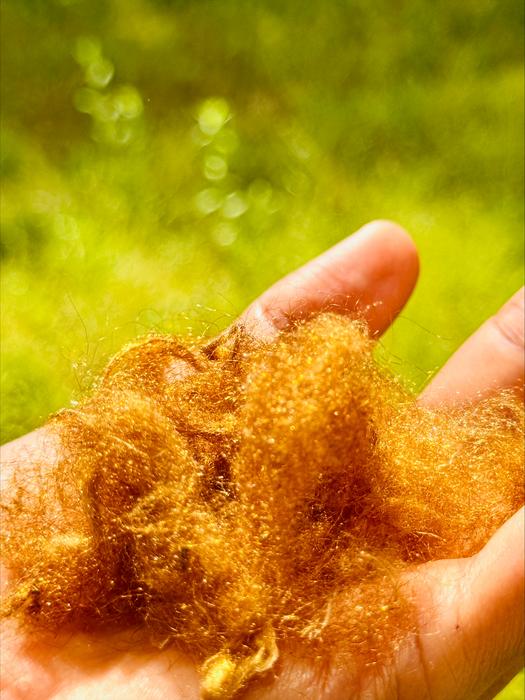In a remarkable fusion of ancient artistry and cutting-edge science, Korean researchers have successfully resurrected the legendary sea silk—a rare and luxurious fiber once exclusively worn by emperors and high-ranking dignitaries over two millennia ago. This revival was achieved by unraveling the secrets embedded within the byssus threads of the pen shell (Atrina pectinata), a bivalve cultivated along Korea’s coastal waters, opening new frontiers in sustainable textile engineering without compromising the fiber’s historically revered golden luster.
Sea silk’s historical mystique originates from its production using the byssus threads of Pinna nobilis, a large, Mediterranean clam whose rarity today has transformed the material into a near-lost art. Valued in antiquity for its extraordinary durability, lightweight texture, and an iridescent golden hue that seemed imperishable, sea silk was famed not only as a symbol of wealth and power but also for its unique optical properties. The Holy Face of Manoppello, an artifact believed to be woven from sea silk, stands as a testament to the fiber’s exquisite craftsmanship and its cultural significance.
However, the natural source of traditional sea silk, Pinna nobilis, faces critical endangerment due to escalating marine pollution and ecological destabilization. Its collection is prohibited under European Union regulations, pushing the limits of sea silk production to near extinction, restricted to a few artisanal masters preserving the craft by hand. This ecological constraint motivated scientists to seek an alternative biological source capable of providing the same exceptional material qualities inherent in sea silk.
Focusing on the pen shell Atrina pectinata, widely farmed and previously overlooked as a potential textile resource, the research team conducted comprehensive physicochemical analyses. The byssus fibers secreted by this species share remarkable structural and compositional likenesses with those from Pinna nobilis, including similar proteinaceous makeup and fiber morphology. This discovery paved the way for biochemical and mechanical processing techniques adapted to transform these byssus threads into a structurally colored sustainable fiber, effectively recreating sea silk from Korean marine resources.
Beyond mimicking the visual characteristics of ancient sea silk, the research tapped into the fundamental science of coloration in these fibers. The radiant golden appearance, traditionally assumed to be dye-based, is in fact a product of sophisticated structural coloration. This optical phenomenon, well-known in biological systems such as butterfly wings and soap bubbles, results from nanoscale protein architectures within the fiber that manipulate light through constructive interference, producing vivid iridescence without pigmentation or chemical dyes.
At the nanoscale, the key element identified is a spherical protein complex termed “photonin,” which aggregates in nested layered structures along the byssus fibers. These protein layers exhibit periodic arrangements with precise spacing on the order of visible light wavelengths, enhancing reflectivity and color stability. Such photonic nanostructures confer a remarkably enduring brilliance, resistant to fading despite prolonged exposure to environmental factors—a quality long cherished in sea silk textiles.
The researchers further elucidated the correlation between protein organization and color vibrancy, revealing that greater molecular order and alignment amplify the iridescent effect. Unlike conventional dyeing or pigmentation methods vulnerable to photodegradation, the organically generated coloration in sea silk is embedded intrinsically in the fiber’s ultrastructure, offering a sustainable route for producing vivid, long-lasting hues without additional chemical inputs.
Moreover, the project exemplifies a transformative approach to marine waste valorization. Pen shell byssus has traditionally been discarded during harvesting for food, representing an underutilized biomass. By converting this biological residue into a high-value fibrous material, the initiative aligns with circular economy principles, reducing environmental impact while fostering innovative bio-based textile development with deep cultural resonance.
This breakthrough not only revives a lost textile heritage but also signals new possibilities for materially engineered fabrics in the context of sustainable fashion and advanced material science. As Professor Dong Soo Hwang from POSTECH explains, “Structurally colored textiles are inherently resistant to fading. Our technology enables long-lasting color without the use of dyes or metals, opening new possibilities for sustainable fashion and advanced materials.” This insight challenges current paradigms in colorant chemistry, highlighting nanostructure engineering as a promising alternative for eco-friendly coloration technologies.
The implications extend into interdisciplinary domains, touching upon environmental science, materials engineering, and biotechnology. By capturing the interplay between biological nanostructures and photonics in a scalable production process, this advancement heralds a new class of multifunctional textiles equipped not only with aesthetic allure but also sustainable credentials. It provides a model for future smart materials that leverage nature’s design principles to address pressing ecological and societal demands.
In essence, the reinvention of sea silk through pen shell byssus threads encapsulates a synergy of heritage, sustainability, and scientific ingenuity. It reaffirms the capacity of nature-inspired design combined with modern analytical techniques to breathe new life into ancient materials, ensuring their relevance and application in the 21st century. By harnessing structural coloration mechanisms and biofabrication, the research offers both a homage to cultural tradition and a blueprint for responsible innovation in textile engineering.
As the field moves forward, continued exploration of marine biomaterials and their nanostructures promises to unlock further exceptional properties applicable to diverse industries. The balance between ecological conservation and advanced technological application achieved in this study highlights a path towards sustainable utilization of marine biota, transforming a forgotten fiber into a beacon of scientific and cultural renaissance.
Subject of Research: Re-creation and scientific analysis of structurally colored sea silk fibers derived from pen shell (Atrina pectinata) byssus threads.
Article Title: Structurally Colored Sustainable Sea Silk from Atrina pectinata
News Publication Date: 29-Apr-2025
Web References: 10.1002/adma.202502820
Image Credits: POSTECH
Keywords: Applied sciences and engineering, Environmental sciences, Pollution control, Materials engineering, Textiles, Textile engineering, Nanomaterials, Nanofabrication, Nanostructures, Shellfish




